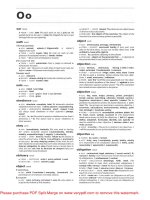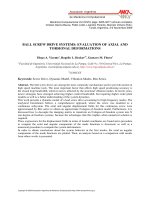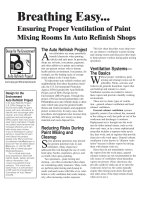Tài liệu BALL SCREW DRIVE SYSTEMS: EVALUATION OF AXIAL AND TORSIONAL DEFORMATIONS docx
Bạn đang xem bản rút gọn của tài liệu. Xem và tải ngay bản đầy đủ của tài liệu tại đây (384.89 KB, 13 trang )
BALL SCREW DRIVE SYSTEMS: EVALUATION OF AXIAL AND
TORSIONAL DEFORMATIONS
Diego A. Vicente
a
, Rogelio L. Hecker
ab
, Gustavo M. Flores
a
a
Facultad de Ingeniería, Universidad Nacional de La Pampa, Calle 9 y 110 General Pico, La Pampa,
Argentina, ,
b
CONICET
Keywords: Screw Drive, Dynamic Model, Vibration Modes, Ritz Series.
Abstract. The ball screw drives are among the most commonly mechanisms used to provide motion in
high speed machine tools. The most important factor that affects high speed positioning accuracy is
the closed loop bandwidth, which in turn is affected by the structural vibration modes. In recent years,
newer strategies have emerged achieving higher control bandwidth, but requiring higher order plant
models as well as a better understanding of the system dynamics.
This work presents a dynamic model of a lead screw drive accounting for high frequency modes. The
analytical formulation follows a comprehensive approach, where the screw was modeled as a
continuous subsystem. The axial and angular displacement fields for this continuous screw were
approximated by Ritz series to obtain an approximate N-degree-of-freedom model. Furthermore, it is
discussed how to decouple the damping matrix to transform an N-degree-of-freedom system into N
one-degree-of-freedom systems, because the advantages that this implies when numerical solution is
required.
Then, expressions for the displacement fields in terms of modal coordinates are found and a procedure
to compute the axial and angular components of the mode functions is discussed, as well as a
numerical procedure to compute the system deformation.
In order to obtain conclusions about the system behavior in the first modes, the axial an angular
components of the mode functions are plotted. Then, an analysis based on a comparison with results
from others works is presented.
Mecánica Computacional Vol XXVIII, págs. 3265-3277 (artículo completo)
Cristian García Bauza, Pablo Lotito, Lisandro Parente, Marcelo Vénere (Eds.)
Tandil, Argentina, 3-6 Noviembre 2009
Copyright © 2009 Asociación Argentina de Mecánica Computacional
1 INTRODUCTION
Traditionally, the dynamics of each axis in a machine tool is represented as a second order
system for which well-known control techniques are applied. In these cases, the rigid body
mode is the only mode that must be included into the control system model. However, when
designing wider bandwidth positioning systems it becomes necessary to consider additional
structural modes. An example is High Speed Machining (HSM), where the feed between the
cutting tool and the workpiece increases proportionally to the increased spindle speed (Smith,
1999). This represents a problem, particularly in machining parts that require short and
repetitive movements demanding high accelerations profiles. High accelerations profiles
excite the machine structure up to high frequencies, thereby exciting the structure vibration
modes. Therefore, for HSM, the traditional models must be augmented with higher order
dynamics, up to 150 Hz, to assist the controller design, (Hecker and Flores, 2005).
On the other hand, the mechatronical design of industrial servosystems requires, in
increasing way, advanced modeling and simulation techniques able to predict the machine
dynamics, which may interact in a non-intuitive way with the control actions.
Smith (1999) used finite elements modeling to analyze a ball-screw positioning system of a
high-speed milling machine. From the model the author predicts the natural frequencies and
the shapes of the first vibration modes. In a similar way, Erkorkmaz and Kamalazadeh (2006)
used a finite element model to study the torsional dynamics of the ball screw mechanism,
from which it was predicted the natural frequencies and shapes of the first torsional modes.
A more comprehensive model was presented by Varanasi (2002), Varanasi and Nayfeh
(2001, 2004), where an accurate model for the first axial mode was obtained. The author
considered the screw as a distributed parameter system and assumed that the axial and
torsional displacement fields vary linearly with the axial coordinate of the screw. Although
the model follows a general formulation, only the frequency of the first mode was predicted
due to the assumptions considered in the solution.
Vicente et al. (2007) presented a dynamic model of a feed drive servomechanism
accounting for high frequency modes. The formulation follows a comprehensive approach
with the screw modeled as a continuous subsystem, where the axial and torsional dynamics
are characterized by continuous functions denominated displacement fields. The displacement
field for the screw was approximated by Ritz series to find a finite dimensional model.
The aim of this work is to propose a way to evaluate the system dynamics of a ball-screw-
drive servosystem based on the model presented by Vicente et al. (2007). First, the model is
constructed using power balance method and using Ritz series to represent the axial and
angular displacement fields. After that, expressions for the displacement fields in terms of
modal coordinates are found from the model solutions. A general procedure to evaluate
numerically the displacement field is discussed as well as a procedure to compute the axial
and angular components of the mode functions. Finally, the mode functions of the first modes
are plotted and analyzed.
2 SERVOMECHANISM MODEL
A typical feed drive servomechanism for precision positioning, such those found in
machine tools, is shown in Figure 1. It consists of a ball-screw assembled to the machine base
by rotary bearings, which is driven by an electric-servomotor through a flexible coupling. The
ball-nut is attached to the carriage that is constrained to move axially on linear bearings and
guideways.
The schematic model considered here is presented in Figure 2, in which the screw is solely
D.A. VICENTE, R.L. HECKER, G.M. FLORES3266
Copyright © 2009 Asociación Argentina de Mecánica Computacional
a continuous system, whereas the remaining elements are assumed in the lumped form. In
these conditions, the screw can be considered as a straight bar with three fundamental types of
deformations: axial deformation, by traction or compression, angular deformation, by torsion,
and flexural deformation. Flexure is discarded, assuming the screw is suitably mounted in the
servomechanism and then minimizing buckling due to non-concentric forces produced by
misalignments.
carriage
guideways
ball-nut
screw
rigid bearing
coupling
motor
Figure 1: Ball-screw feed system
In this way, the continuous deformation can be represented by an axial displacement using
a field function u(x,t) and by an angular displacement using
θ
(x,t). This continuous portion is
characterized by mass-density
ρ
, cross-section A, moment of inertia J
t
, length L, Young’s
modulus E, Poisson’s modulus G, and screw lead l (also cited as transmission ratio).
The elements assumed in the lumped form are the rotor of the electric motor with moment
of inertia J
m
, the flexible coupling with moment of inertia J
a
and stiffness k
a
, the rigid bearing
with stiffness k
b
, and the carriage with mass m
c
.
u(0,t)
b
k
f(t)
,t)
u(x
c
n
k
m
c
c
c
u (t)
c
( a )
(t)
j
m
k
a
c
m
c
r
( b )
2
l
j =
c
m
.
c
(0,t)
m
(t)
,t)
(x
c
n
kl
2
.
c
n
Figure 2: Schematic of the ball-screw feed system. (a) Axial. (b) Angular.
As Figure 2 shows, in addition to the generalized coordinates from the continuous portion,
there are two additional generalized coordinates, one to describe the carriage position u
c
(t)
and another to describe the rotor angular position
θ
m
(t).
2.1 Power balance fromulation
A convenient approach to obtain motion equations in this kind of systems is the power
balance method based on energy and work formulation, (Ginsberg, 2001).
The general formulation of the power balance law for a vibratory system is
in dis
TV P P+= +
(1)
where
T
and
V
are the kinetic and potential energy of the system, whereas
P
in
and
P
dis
are the
power input and the power dissipation in the system.
Using the defined variables, the kinetic energy can be computed as follows
Mecánica Computacional Vol XXVIII, págs. 3265-3277 (2009) 3267
Copyright © 2009 Asociación Argentina de Mecánica Computacional
() ()
() ( )
() ()
2
22
22
00
0,
111
2222
11
22
m
cc mm a
LL
t
θ t θ t
Tmut Jθ tJ
ρ J θ x,t dx ρ Aux,t dx
⎛⎞
+
=++
⎜⎟
⎜⎟
⎝⎠
++
∫∫
(2)
where the first and the second terms represent the contributions from the mass of the carriage
and the inertia of the rotor respectively. The third term is the energy from the flexible
coupling, for which an average speed between the angular velocity of the rotor and the
angular velocity of the screw in x = 0 was considered. The fourth and the fifth terms represent
the kinetic energy from the distributed rotary inertia and the distributed linear inertia of the
screw respectively.
The potential energy stored in the elastic parts of the system can be computed according to
() () ( )
() ()
2
2
2
22
00
11 1
0, 0,
22 2
11
22
bam nn
LL
t
Vkut k t t k
dx,t dux,t
J G dx E A dx
dx dx
θ θδ
θ
=+−+⎡⎤
⎣⎦
⎛⎞ ⎛⎞
++
∫∫
⎜⎟ ⎜⎟
⎝⎠ ⎝⎠
(3)
where the first and second terms correspond to the potential energy in the rigid bearing and
flexible coupling respectively. Similarly, the third term corresponds to the potential energy
stored in the ball-nut, where k
n
is the nut’s stiffness coefficient and δ
n
is the axial deformation
in the nut. Although the elastic deformations produced by the normal contact forces have
axial and radial components (Wei and Lin, 2003), only the axial component influences the
axial displacement field.
Therefore, the interface axial deformation can be expressed as
( ) ( ) ( )
( )
,,
nc c c
ut uxt xtl
δθ
=− +
(4)
that denotes the difference between the absolute position of the carriage, u
c
(t), and the
absolute position of the screw at the interface-point coordinate x
c
. It is important to notice that
Eq. (4) involves axial and torsional displacements together, producing a coupling of both
displacements, a fact that forbids each field to be treated separately. Alternatively, the fourth
and the fifth terms of Eq. (3) represent the potential energy stored in the continuous portion of
the system, the screw, by torsional and axial displacements.
The power input to the system results in
( ) ( ) ( )
,
in m m f c c c
Ptxtfut
τθ τθ
=− −
(5)
where the first term is the power input from the motor, the second term is the coulomb friction
dissipation in the ball-nut due to the friction torque
τ
f
, and the third term represents the power
required to move the carriage at the velocity
c
u
against a disturbance force f
c
. Note that f
c
is a
general variable to account for external forces actuating on the carriage, which can include
machining forces and coulomb friction forces in guideways.
Alternatively, the power dissipation in the system due to viscous friction can be expressed
as follows
D.A. VICENTE, R.L. HECKER, G.M. FLORES3268
Copyright © 2009 Asociación Argentina de Mecánica Computacional
() ( ) ( ) ()
22
00
22 22
(,) (,)
0, ,
LL
dis t
mm b n c cc
du x t d x t
PEA dxGJ dx
dx dx
ctc tcxtcut
θ
γγ
θθ θ
⎛⎞ ⎛⎞
=+
⎜⎟ ⎜⎟
⎝⎠ ⎝⎠
++ + +
∫∫
(6)
The first two terms represent the power dissipation due to the viscoelastic behavior of the
continuous portion. The other four terms represent the power dissipation in rotor bearings,
rigid bearing, ball-nut, and guideways, respectively. Therefore, the coefficients c
m
, c
b
, c
n
and
c
c
are the viscous friction coefficients of these elements.
All the above equations depend on the displacement fields u(x,t) and
θ
(x,t) that must be
formulated. A rigorous treatment of vibrations of continua requires the solution of exact field
equations, that is to say, equations governing deformations that depend on time and spatial
coordinates. An alternative and convenient method is the approximation of these equations by
a Ritz series as is described in the next section.
2.2 Basis functions selection and close loop form system representation
The deformation in a continuous general system can be represented by a displacement field
u(x,t) that is a function of the time and the spatial coordinates. The Ritz series method,
(Ginsberg, 2001), also known as method of assumed modes, uses a series expansion to
approach the displacement field as follows
() ()()
1
N
jj
j
ux,t xq t
ψ
=
=
∑
(7)
where the basis functions
ψ
j
(x) represent the displacement field as a function of the x
coordinate and the coefficients q
j
(t) represent the instant contribution of
ψ
j
(x) over the
displacement field.
From a mathematical perspective, Eq. (7) maps a continuous function over an N-
dimensional space whose directions are the functions
ψ
j
, so these functions are called basis
functions. The coefficients q
j
represent projections of u in the direction of each basis
functions. The approach using the Ritz series will be a discrete model with N degree of
freedom that approximates the behavior of a system with infinites degrees of freedom.
The basis functions must fulfill certain conditions to obtain a valid formulation of the Ritz
series. All basis functions must be continuous, linearly independent and must satisfy the
geometric boundary conditions (Ginsberg, 2001). In this way a suitable axial field equations
can be constructed using cosine basis functions.
()
1
cos ( )
u
u
u
N
j
j
x
ux,t q t
L
α
=
⎛⎞
=
⎜⎟
⎝⎠
∑
(8)
where
α
= ( j
u
-
1)
π
. The first term in the series (with j
u
= 1) is the unitary function that
represent the rigid body motion which is kinematically admissible for this system. This is
because the screw is attached to the base by the bearing, which is modeled as a lumped
spring, as Figure 2a shows. Therefore, although the rigid body motion would not actually
occur, it is advisable to introduce a unitary function to account for stiffness differences
between the screw and the rigid bearing (Ginsberg, 2001).
It is more obvious that the screw has a rigid body motion for the angular displacement;
then, the displacement field to describe rotation in the screw can be represented by
Mecánica Computacional Vol XXVIII, págs. 3265-3277 (2009) 3269
Copyright © 2009 Asociación Argentina de Mecánica Computacional









